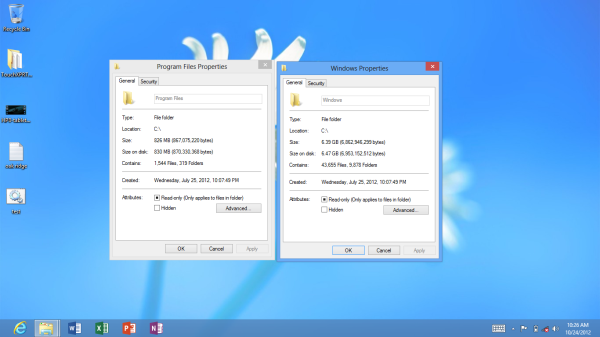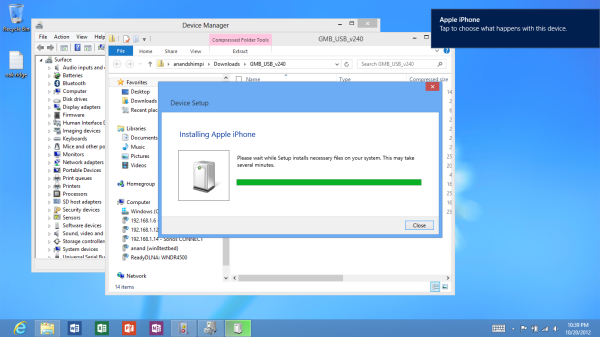The Windows RT Review
by Vivek Gowri & Anand Lal Shimpi on October 25, 2012 12:00 PM EST- Posted in
- Windows RT
- Operating Systems
- Microsoft
- Mobile
- Windows 8
- Tablets
UI Performance, Storage, and USB Compatibility
by Vivek Gowri and Anand Shimpi
With Windows Phone 7, Microsoft did a great job of taking generation-old hardware and delivering a great user experience in spite of any silicon-level deficiencies. So naturally, with the new Windows UI, we were expecting a very smooth UI regardless of the underlying hardware. And they’ve most certainly delivered on that.
Animation frame rates are consistently good all the way through the UI, easily delivering what appears to be 60 fps for UI transitions. When pushed, Modern UI seems more likely to completely drop animations versus dropping frames, which eliminates the choppy experience you sometimes find in Android. It isn’t a common occurrence, the experience is generally very fluid. This kind of consistently smooth UI is what Google has been striving for in every recent release of Android, dedicating the release of 4.1 to eliminate the dropping of frames in even basic interactions. Scrolling, swiping, snapping, app switching - it doesn’t really matter what you’re doing, RT is just really smooth. Combined with the fluidity of the gestures, the entire system just feels like liquid, there are just no real slowdowns even running on a no-longer impressive SoC like Tegra 3.
| Application Launch Time Comparison | |||||||
| Boot | Web Browser | Maps | Games Center / Xbox | ||||
| Apple iPad (3rd gen) | 32.0s | 1.0s | 2.4s | 1.1s | 1.9s | ||
| Microsoft Surface | 27.7s | 2.6s | 7.1s | 5.0s | 5.0s | ||
But there is one area that RT struggles in, and it’s something that was an issue in Windows Phone 7 too - application launch times. Anand included this table in his Surface review, and it shows that boot performance is decent, but the 3rd generation iPad just kills it in application loading. The new A6X-infused 4th gen iPad probably widens that gap too, so it’s a pretty stark difference. It’s something that Microsoft needs to really focus on when updating the OS, because it’s easily one of the most glaring flaws in an otherwise stellar interface.
From a storage standpoint, the OS takes up between 6.5 and 7.5GB of space (Anand measured 6.47GB on Surface, I measured 7.35GB on the VivoTab RT) and Office takes up another 750-850MB (830MB for Surface, 749MB for the ASUS), so you’re looking at 7.5-8GB of NAND dedicated to the OS. On my 32GB VivoTab RT, I had 25.3GB of storage to start with, so after Windows and Office, I was looking at 17GB left over for programs and documents. That’s....not a lot - a bit of music, a decent selection of applications, a couple of videos, and pretty soon I’m looking at less than 10GB of storage left over. Thankfully, we’re seeing microSD slots on a lot of the more prominent Windows RT slates, so if you run out of room, you could theoretically toss in a 32GB or 64GB microSDXC card. Depending on how much data you plan on storing, I think you can get away with the lesser internal NAND and some microSD cards.
It’s also pretty clear that there will not be a Windows RT slate shipped with less than 32GB of onboard NAND. If you’re holding out for a cheaper Windows RT device with less storage, like a 16GB tablet for $399, there’s almost no way that happens - it’s implausible to think that anyone would ship a tablet with less than 5GB of space left for data storage.
Another key detail in Windows RT is wide-ranging USB peripheral support. USB ports have been a common feature on 10” Android tablets, but device support was typically limited to flash drives and basic input devices. The goal with Windows RT was to bring the traditional Windows experience to tablets, so USB driver support is pretty important. It’s not as easy as on an x86 system, where most USB peripherals would just work, but even with more limited Windows-on-ARM drivers, it’s pretty decent overall.
USB drives obviously work as you’d expect them to. Even SATA to USB adapters worked fine when plugged into Surface. Other smartphones and tablets also worked, although their level of support varied. For example, you can plug in the iPhone 5 and have it come up as a supported device for moving pictures to/from. However USB tethering is not supported by the class driver included in Windows RT. You can even plug an iPad into Surface and get the same level of support. The few Android phones I tried to connect in MTP all worked as expected, though transfer rates off my Optimus 4X HD seemed on the slow side, likely a function of the phone’s internal eMMC.
Printer support is pretty decent, although the Epson Workforce 910 Anand tried didn’t actually have specific driver support under RT. Although development for the desktop side of Windows is limited, manufacturers can supply Windows RT drivers to enable support for some more obscure devices. Unfortunately when it comes to those devices you’ll have to play the waiting game as there’s simply not a lot of third party Windows RT drivers available for download today.












233 Comments
View All Comments
steven75 - Friday, November 2, 2012 - link
Huge problem. Windows 8 x86 != Windows RT compatible version.There's basically no reason to make Metro apps if you already have a working x86 app unless RT is some kind of phenomenon.
Oxford Guy - Thursday, October 25, 2012 - link
horrifyinghttp://images.anandtech.com/doci/6392/Music-Sideba...
http://images.anandtech.com/doci/6392/Screenshot%2...
http://images.anandtech.com/doci/6392/Charms.png
bad
http://images.anandtech.com/doci/6392/TaskSwitcher...
Sharp edges everywhere. Playskool colors without the roundness that makes Playskool stuff far less wretched. Misdirection aplenty.
No way. Sticking with iOS.
Oxford Guy - Thursday, October 25, 2012 - link
I think that third pic should be called the schizophrenia design language.kyuu - Thursday, October 25, 2012 - link
... Are you talking about the *background*? You're seriously going to leverage a complaint about the OS based on the *background image*?Wow.
Oxford Guy - Thursday, October 25, 2012 - link
I am not just talking about the background.kyuu - Thursday, October 25, 2012 - link
Lol.Aesthetics are, of course, completely subjective, but complaining about Metro/Modern-UI while sticking with the chiclets-on-a-grid iOS just seems silly to me.
Oxford Guy - Thursday, October 25, 2012 - link
Aesthetics is not an area that is anywhere near being completely subjective. For instance, eye tracking research has found that men look at crotches and women don't. There is a lot of psychology involved in designing an attractive and usable interface. Unfortunately, a lot of designers think aesthetics is a more subjective field than it is. Many think, erroneously, that what works well on paper works well on the screen, too.Those photos present clutter, disorder, sharp edges, and other unpleasant design attributes. The giant sharp-edged colored box look that's so prevalent is jarring, unpleasant, and unfortunate.
iOS's chiclets, at least, have softer more humanized edges and adequate space between. The soft rippled background on my iPhone 5 is also more humane than the schizoid gizmo look.
If you think aesthetics is totally subjective, explain why Microsoft Bob didn't succeed. Why don't all our computers look like THAT?
ludikraut - Friday, October 26, 2012 - link
I guess that must make me a schizo then, since I disagree with all of your points.l8r)
Dorek - Friday, November 2, 2012 - link
What, are you worried you'll cut yourself?Devo2007 - Thursday, October 25, 2012 - link
"Swipe in from the left and you flip through apps, giving Microsoft the win for quickest task switcher among all tablets"While it's not iOS or Android, the BlackBerry PlayBook can swipe through apps by swiping in from the left or right. So in this case, I'd call it a tie.